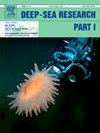北太平洋西部亚北极、过渡和亚热带地区3000 m以下浮游动物大小光谱的垂直变化及其对Calanoida和Ergasilida大小的显著影响
IF 2.1
3区 地球科学
Q2 OCEANOGRAPHY
Deep-Sea Research Part I-Oceanographic Research Papers
Pub Date : 2025-01-18
DOI:10.1016/j.dsr.2025.104445
引用次数: 0
摘要
浮游动物大小光谱是评价海洋生态系统结构的重要指标,桡足类是海洋浮游动物群落中的优势类群。在桡足类中,Calanoida和Ergasilida是数量上占优势的两个类群。尽管它们很重要,但关于这两个分类群对整个浮游动物大小光谱的影响的信息有限。本研究旨在综合评价北太平洋西部亚北极、过渡和亚热带地区浮游动物尺寸谱、标准化生物量尺寸谱(NBSS)和尺寸多样性的区域和垂直变化。此外,本研究还探讨了两种优势桡足类群Calanoida和Ergasilida的大小变化对浮游动物总体大小光谱的影响。为了实现这一目标,在北太平洋西部亚热带到亚北极的五个站点,从海面到3000米深处,从12层收集了垂直分层的浮游动物样本。使用ZooScan对样品进行分析,以评估浮游动物的总体尺寸光谱以及Calanoida和Ergasilida对其的影响。所有站点的NBSS坡度都趋于中等,且随着深度的增加,尺寸多样性增加,其中氧最小层(OML)在约1000 m深度表现得尤为明显。这些模式反映了大型浮游动物在深海中所占的比例较高,而在浅层附近,来自微食鱼类的捕食压力较低。Calanoida和Ergasilida分别占平均浮游动物丰度的43.3%和24.6%。在这两个分类群中,Calanoida的体型随站位和深度的变化显著,在亚北极地区和较深的地层中体型较大。相对于位置和深度,Ergasilida的体型变化很小。琵琶鱼的体型对整个浮游动物的体型谱有显著影响。因此,大型Calanoida的优势导致了中等的NBSS斜率和总体浮游动物尺寸谱的高多样性。本研究结果表明,Calanoida的大小是浮游动物群落的优势分类单元,主要决定了整个浮游动物群落的大小光谱。本文章由计算机程序翻译,如有差异,请以英文原文为准。
Vertical variations in zooplankton size spectra down to 3,000 m depth and significant effects of the sizes of Calanoida and Ergasilida across the subarctic, transitional, and subtropical regions of the western North Pacific
Zooplankton size spectra are crucial for evaluating marine ecosystem structure, with copepods being the predominant taxa within the marine zooplankton communities. Among copepods, Calanoida and Ergasilida are the two numerically dominant taxa. Despite their importance, limited information exists regarding the effects of these two taxa on the overall zooplankton size spectra. This study aimed to comprehensively evaluate the regional and vertical changes in zooplankton size spectra, normalised biomass size spectrum (NBSS), and size diversity across subarctic, transitional, and subtropical regions of the western North Pacific Ocean. Additionally, the study aimed to investigate the effects of size variations in two dominant copepod taxa, Calanoida and Ergasilida, on the overall zooplankton size spectra. To achieve this, vertically stratified zooplankton samples were collected from 12 layers, ranging from the sea surface to a depth of 3000 m, at five stations across the subtropical to subarctic western North Pacific. The samples were analysed using ZooScan to assess the overall zooplankton size spectra and the effects of Calanoida and Ergasilida on it. Across all stations, the NBSS slopes became moderate, and the size diversity increased with increasing depth, particularly evident for the oxygen minimum layer (OML) at approximately 1000 m depth. These patterns reflect a high proportion of large-sized zooplankton in the deeper layers and a lower predation pressure from micronektonic fish around the OML. Calanoida and Ergasilida accounted for 43.3% and 24.6% of the mean zooplankton abundance, respectively. Among the two taxa, Calanoida exhibited significant changes in body size depending on the station and depth, being larger in the subarctic region and deeper layers. Ergasilida showed minimal changes in body size relative to location and depth. The body size of Calanoida significantly influenced the overall zooplankton size spectra. Therefore, the dominance of large-sized Calanoida induced a moderate NBSS slope and high size diversity in the overall zooplankton size spectra. The results of this study indicate that the size of Calanoida, the dominant taxon in the zooplankton community, primarily governs the size spectra of the overall zooplankton community.
求助全文
通过发布文献求助,成功后即可免费获取论文全文。
去求助
来源期刊
CiteScore
4.60
自引率
4.20%
发文量
144
审稿时长
18.3 weeks
期刊介绍:
Deep-Sea Research Part I: Oceanographic Research Papers is devoted to the publication of the results of original scientific research, including theoretical work of evident oceanographic applicability; and the solution of instrumental or methodological problems with evidence of successful use. The journal is distinguished by its interdisciplinary nature and its breadth, covering the geological, physical, chemical and biological aspects of the ocean and its boundaries with the sea floor and the atmosphere. In addition to regular "Research Papers" and "Instruments and Methods" papers, briefer communications may be published as "Notes". Supplemental matter, such as extensive data tables or graphs and multimedia content, may be published as electronic appendices.

 求助内容:
求助内容: 应助结果提醒方式:
应助结果提醒方式:


